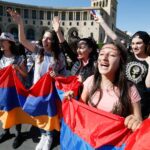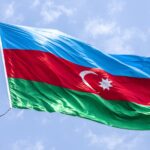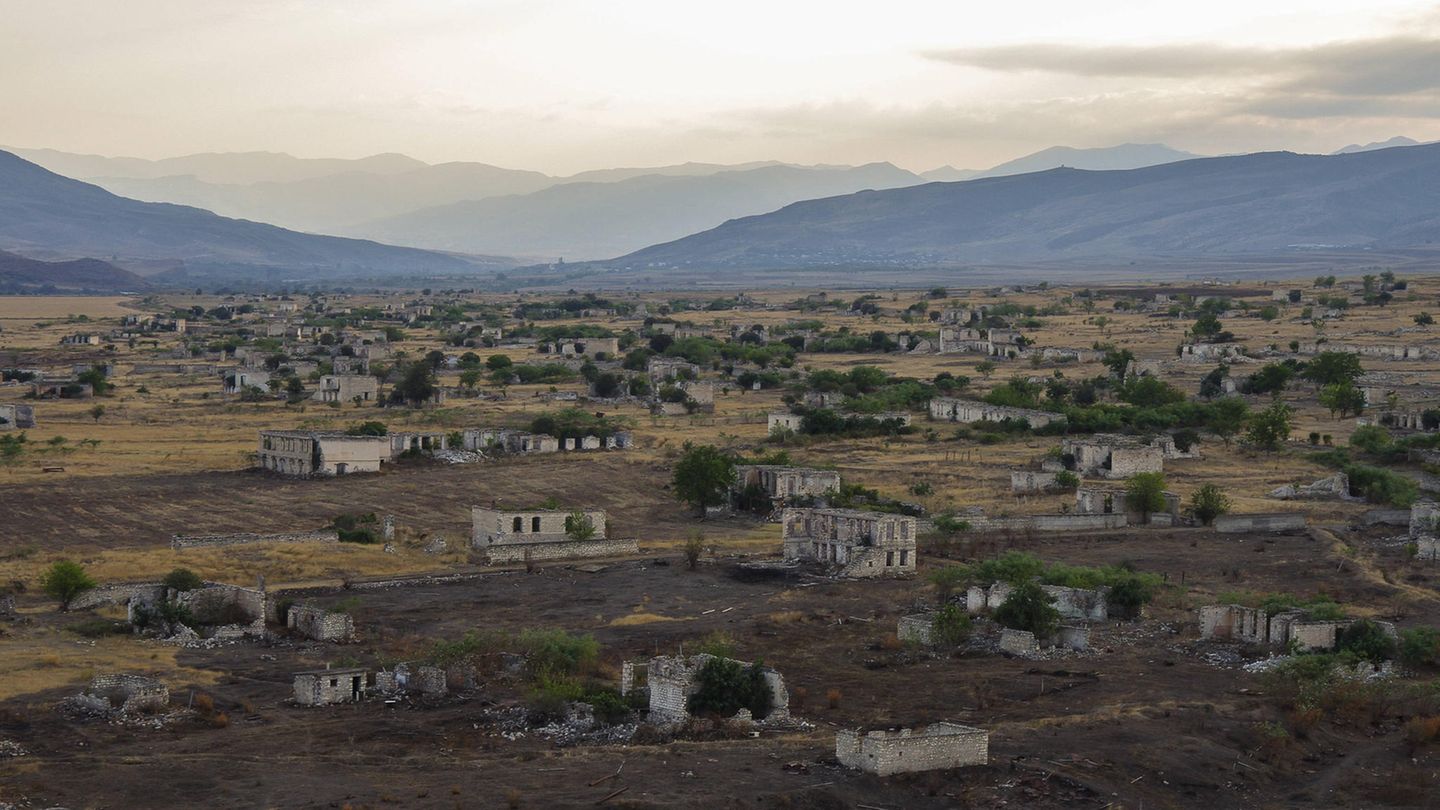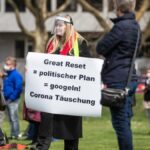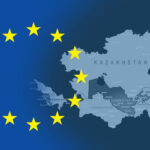Introduction
The Second Karabakh War, also known as the 44-day war, began on September 27, 2020, and ended on November 10, 2020, with the signing of a trilateral ceasefire declaration. This conflict between Azerbaijan and Armenia culminated decades of tension over Nagorno-Karabakh, a region internationally recognized as part of Azerbaijan but occupied by Armenian forces since the early 1990s.
Azerbaijan’s victory in this war restored its territorial integrity and marked a significant step toward resolving the conflict. President Ilham Aliyev has frequently emphasized that truth and international law support Azerbaijan’s position, and regaining control over Karabakh is a just outcome of the struggle for its rightful claims.
More than $7 billion has been spent so far on the restoration of Karabakh, and these expenditures are expected to grow. The main goals of rebuilding Karabakh include restoring the destroyed infrastructure, resettling internally displaced persons, developing the region’s economic potential, and ensuring sustainable development. Key priorities are demining the areas, constructing transport and energy infrastructure, creating industrial and logistics parks, and boosting agriculture and tourism.
Rebuilding Karabakh holds immense significance for Azerbaijan and the region. This process is strategically important for the country, as it enhances national security, improves the economic situation, and raises the living standards of its people. The restoration of Karabakh also opens new opportunities for regional cooperation and development. Creating modern infrastructure and conditions for economic growth in the liberated areas will be a crucial factor in the stabilization and prosperity of the entire South Caucasus.
Demining Operations
Clearing the liberated areas of Karabakh from mines and unexploded ordnance is one of Azerbaijan’s most critical and challenging tasks. Decades of occupation by Armenian forces left these lands heavily mined, posing a serious threat to returning residents and beginning reconstruction work. Estimates indicate about 15 million mines and other explosive devices are planted in the liberated areas. By March 2024, 53,081.8 hectares had been cleared, with 3,495 anti-personnel mines, 5,034 anti-tank mines, and 23,049 unexploded ordnance neutralized. The total cost of demining is estimated at $25 billion.
According to information from the Azerbaijan National Agency for Mine Action (ANAMA), during the mine clearance activity conducted by the institutions engaged in mine clearance from November 10, 2020, to February 14, 2024, a total of 118,502.6 hectares of land have been cleared. During this clearance, 62,228 unexploded ordnances, 31,175 anti-personnel mines, and 18,790 anti-tank mines (total: 112,193) were discovered and rendered safe.
Throughout this period, there have been 361 mine casualties, with 293 injured and 68 fatalities (02.06.2024).
Moreover, ANAMA uses robots and special mechanized systems for demining, significantly reducing the risk to human deminers. Organizations like The Halo Trust support by training local specialists, conducting demining operations, and providing technical assistance and equipment.
International cooperation is crucial for successful demining in Karabakh. Organizations such as The Halo Trust and other international NGOs provide technical assistance and funding for operations. These organizations work closely with the Azerbaijani government and ANAMA, ensuring the exchange of experience and best practices.
Partner countries also provide significant support through funding and equipment for demining. The joint efforts of Azerbaijan and the international community aim to make the liberated areas safe for the return of the population and the start of economic activities as soon as possible. The contributions of international organizations and partners highlight the importance of global cooperation in addressing the humanitarian and economic challenges Azerbaijan faces in rebuilding Karabakh.
Infrastructure Restoration
Rebuilding transport infrastructure is a key part of Azerbaijan’s efforts to revive Karabakh. Constructing and modernizing roads and railways aims to improve transport accessibility, essential for the region’s economic development and the return of the population.
Tunnel Construction
Azerbaijan is actively constructing tunnels in the liberated areas of Karabakh, such as Shusha, Lachin, and Kelbajar. The main goal of these projects is to improve transport infrastructure and create conditions for safe and convenient movement. In total, tunnels with a total length of 62 kilometers are planned to be built.
Key projects include the Murovdag Tunnel on the Toghanaly-Kelbajar road, which is 11.6 kilometers long. This is the longest tunnel in Azerbaijan, and 350 meters of the tunnel have already been completed. The Kelbajar-Lachin Tunnel, 3.5 kilometers long, is part of a broader project to connect the Lachin and Kelbajar districts.
In Shusha, two tunnels have already been constructed, with lengths of 431 and 530 meters respectively. The total length of the tunnels in this area will be about 6500 meters. Other tunnels on the Kelbajar-Lachin road include 12 sections with a total length of 7596.5 meters. These tunnels will have one lane in each direction and a width of 11.60 meters. In Kelbajar and Lachin, more than 10 tunnels are planned, the longest of which will be about 12 kilometers long. These tunnels are necessary to improve connections between districts and ensure safe passage.
Additionally, in Karabakh and Zangezur, 9 viaducts and numerous bridges are being constructed, which includes laying roads and creating the necessary infrastructure to maintain transport communication. Turkish companies are involved in the works, with about 6587 workers employed, including 1832 Turkish citizens and 4500 Azerbaijani citizens. These projects aim to develop transport infrastructure, improve connections between various districts, and create conditions for safe movement for both civilian populations and military purposes.
Roads
Azerbaijan is actively implementing major road construction and modernization projects in Karabakh and East Zangazur, aiming to restore and develop infrastructure in the liberated areas.
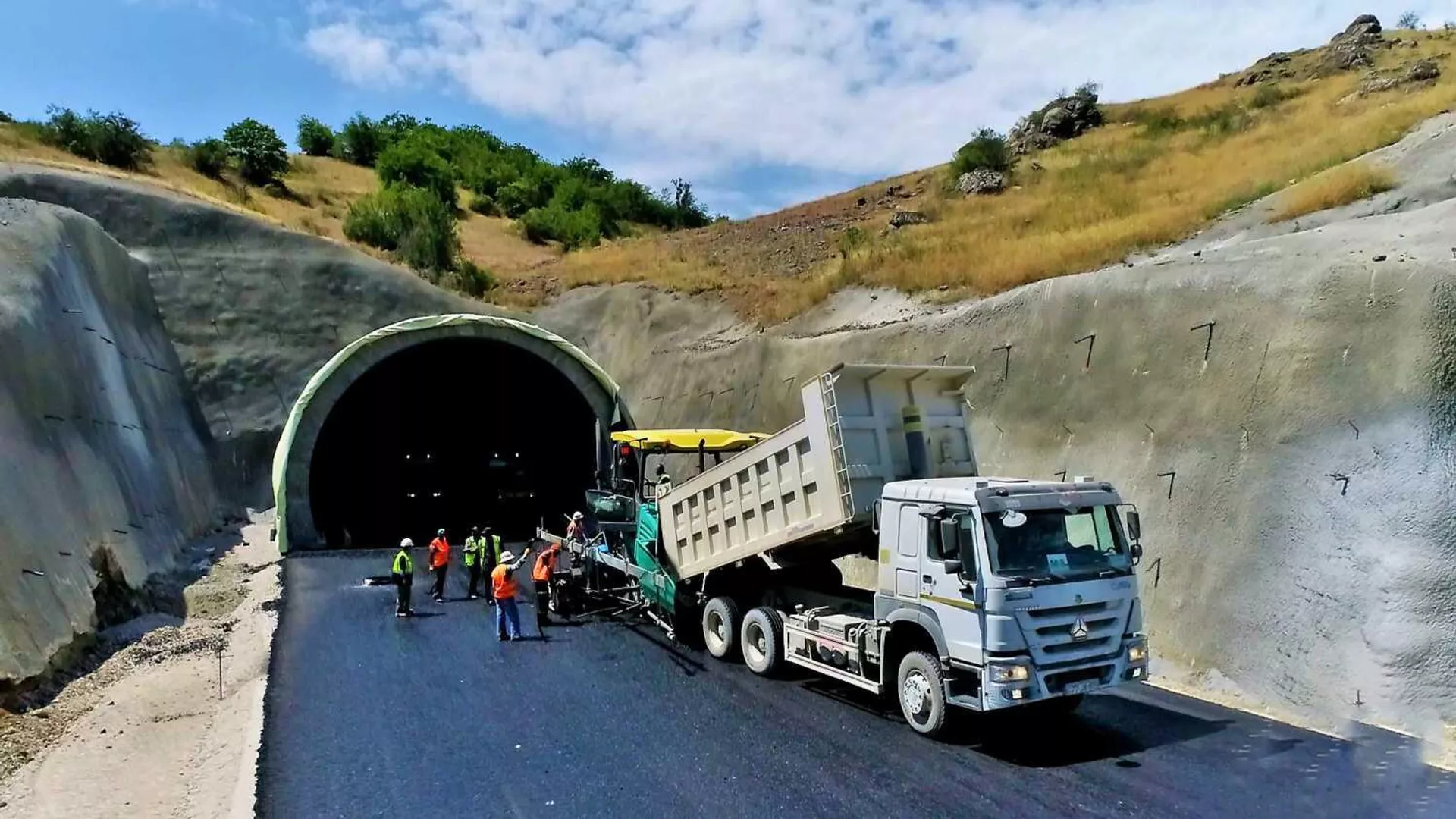
Significant projects include Ahmedbeyli-Fuzuli-Shusha Road, also known as the “Victory Road,” a 101.5 km road that connects key areas of the liberated territories and aims to improve transport access to the strategically important city of Shusha. The Toghanaly-Kalbajar-Istisu and Kalbajar-Lachin roads support the economic development of remote areas, providing reliable transport links between different parts of the region. The Sugovushan-Talish Road, a 75 km road from Terter to Talish with a 9-meter-wide asphalt surface, is vital for infrastructure restoration, ensuring access to newly liberated territories and supporting the return of internally displaced persons.
The Khudafarin-Lachin Road, a 56.4 km road passing through the Khudafarin reservoir and connecting to Lachin, includes 14 km of new roads from Khudafarin to Kubadly. Additionally, the Kubadly-Eyvazly and Kubadly-Khindzirek roads measure 26 km and 23.5 km respectively, with a roadbed width of 3.5 meters. The Zangezur Corridor projects, undertaken by the company “Kalyon,” include constructing roads such as a route to the international airport in Zangezur, along with 7 road junctions. The Goygol-Kalbajar Highway, an 81 km highway, enhances connectivity within the region. The Toghanaly-Kalbajar-Istisu Highway stretches 76 km and includes 23 bridges with a total length of 4.1 km. Lastly, the Horadiz-Zangilan Highway, a 61 km highway, has been fully reconstructed after being heavily damaged during the occupation. These projects are aimed at fostering economic growth and improving connectivity between regions, significantly contributing to the overall development of the liberated territories.
Railways
Restoring railway infrastructure is crucial for improving logistics and speeding up cargo and passenger transport. Key projects include:
Barda-Aghdam Railway: This 45 km railway line, built in two phases (19 km to Tazakend and 26 km to Aghdam), aims to restore connections between important economic centers in the region.
Horadiz-Aghbend Railway: This line will be part of the Zangazur Corridor, linking Azerbaijan with the Nakhchivan Autonomous Republic through Armenia, strategically altering the South Caucasus’s transport architecture.
The occupation of territories by Armenia inflicted serious damage to the railway infrastructure of Azerbaijan, with 240.4 kilometers of railways under occupation. However, on the liberated territories, efforts are underway to restore and build new railway tracks, stations, and bridges, which were previously destroyed by Armenians.
The Azerbaijan Railways CJSC (ADY) is actively engaged in the restoration and construction of railway lines in these areas. This includes key projects such as the Barda-Aghdam and Goradiz-Agbend routes, as well as the construction of the new Fizuli-Shusha line.
Moreover, as part of a broader initiative to rebuild and expand the country’s railway network, the construction of railway mainlines and roads totaling 855 kilometers in length, along with tunnels spanning 66 kilometers in total, is envisaged. These efforts aim to enhance connectivity, facilitate transportation, and promote economic development in the region.
By the way, let’s separately touch upon the Swiss-Azerbaijani cooperation experience in the context of railways.
Back in 2012, a meeting was held between the leadership of the Passenger Transportation Department of ADY and representatives of Switzerland’s Stadler Rail. Stadler introduced itself, and collaboration prospects were discussed. Three years later, in 2015, a contract was signed between ADY and Switzerland’s Stadler Rail Group for the purchase of five double-decker trains of the KISS brand.
At the end of last year, several new FLIRT trains, including 6 electric and 4 diesel units, were delivered to Baku Railway Station under a contract between ADY and Switzerland’s Stadler Rail Group.
Each train consists of 5 carriages with a capacity of 236 to 270 passengers, including 8 first-class seats. The diesel trains operate independently of the contact network using their internal engine systems.
Equipped with next-generation safety technology, the trains feature the “Block-5” system, which ensures safe travel by tracking the trajectory of other trains and adjusting speed accordingly. If a driver experiences health issues, the system can stop the train remotely.
The trains also offer continuous high-speed internet through Fluidmesh technology and an onboard multimedia system for entertainment. Additionally, they feature a bar-car lounge where passengers can purchase drinks and snacks during regional trips.
All this suggests that Switzerland, with its rich railway traditions and global leadership in this field, can play a very valuable role in the restoration and development of Karabakh’s railway infrastructure.
International Airports
The constructed and planned airports play an important role in the recovery and development of the liberated territories of Karabakh. One of the key facilities is the Fizuli International Airport, opened in October 2021. Its construction took only eight months and cost $75 million. This airport meets the highest international standards and is capable of accommodating all types of aircraft. The Fizuli Airport has already hosted international flights several times, including visits by the presidents of Turkey, Kazakhstan, Uzbekistan, and Belarus, while President Ilham Aliyev departed from Fizuli to Berlin, highlighting the strategic importance of the airport, referred to as the “Gateway to Karabakh.”
In addition to Fuzuli Airport, Azerbaijan has also opened an international airport in Zangilan, with another one soon to open in Lachin. These projects aim to create modern transport hubs that will ease access to the regions and support their economic development.
International airports are crucial for integrating Karabakh’s liberated territories into the national and international transport system. They ensure the region’s transport accessibility, essential for developing trade, tourism, and attracting investments. Airports accelerate economic activity, improve logistics, and provide reliable connections between different parts of the country and international partners.
Moreover, developing international airports boosts tourism in the region. Convenient and modern transport hubs make Karabakh more accessible to tourists, stimulating the growth of tourist infrastructure, creating new jobs, and improving the region’s economic situation. Tourists can quickly and comfortably reach historical and cultural landmarks like Shusha, enhancing the region’s international appeal.
Energy
Restoring power supply and developing renewable energy are vital aspects of Azerbaijan’s strategy for reviving Karabakh. Stable and reliable power supply is essential for the successful resurgence of the region and ensuring sustainable economic growth.
Karabakh has significant potential for utilizing renewable energy sources, including solar, wind, and hydropower. Solar energy is particularly promising, with annual solar radiation of about 1600-1800 kWh/m², making solar panels efficient and economically viable. Wind energy also has substantial potential, especially in mountainous areas, with wind speeds at 50 meters reaching 6-7 m/s, suitable for wind turbines. Hydropower is another crucial area for renewable energy development, leveraging the region’s rivers and water bodies to construct hydropower plants.
Azerbaijan is focusing on restoring and modernizing the electrical infrastructure in the liberated areas. In cities such as Shusha, Aghdam, Jabrayil, Fuzuli, Kalbajar, Gubadli, and Zangilan, power substations with capacities of 110/35/10 kV are being constructed. These substations play a crucial role in providing reliable and uninterrupted electricity to all consumers in the region, which is particularly important for sustainable development and economic stability.
Alongside restoring traditional energy infrastructure, Azerbaijan is actively promoting renewable energy. The country plans to significantly increase the share of renewable energy sources in its overall energy balance, giving special attention to the construction of hydroelectric power stations and the development of solar and wind energy.
Projects for Building Hydroelectric Power Stations and Creating a “Green Energy Zone”
Restoring and building new hydroelectric power stations are critical parts of ensuring the region’s energy security and reducing dependency on traditional fuels. The plan includes constructing 23 hydroelectric power stations on the rivers Tartarchay, Lev, Garahan, Maydan, Mikhan, Khodjasu, and Zabukh. These projects will significantly boost electricity production from renewable sources, contributing to sustainable development and improving the region’s ecological situation.
Azerbaijan’s strategy also includes creating a “Green Energy Zone” in Karabakh and East Zangazur. This zone will see the implementation of various projects for installing solar panels and wind turbines. These projects aim to significantly reduce carbon dioxide emissions and improve the region’s environmental conditions. The development of renewable energy not only promotes sustainable growth but also creates new jobs, attracting investments into the region.
The creation of the “green energy zone” involves using modern technologies and innovative solutions to enhance energy production and consumption efficiency. This approach ensures stable and effective power supply for future generations and marks an important step toward environmentally friendly and sustainable development in Azerbaijan.
Creating Industrial and Logistics Parks
The goal of establishing industrial and logistics parks in the liberated areas of Karabakh is to stimulate economic growth and regional development by attracting investments, creating jobs, and improving infrastructure. These parks offer favorable conditions for business operations, encourage the growth of small and medium enterprises, and strengthen economic ties with other regions and countries.
The Aghdam Industrial Park, established by a decree from the President of Azerbaijan on May 28, 2021, covers 190 hectares, fully cleared of mines and unexploded ordnance. A mobile town has been built for the park’s residents. The park has attracted significant interest from entrepreneurs, with several projects already underway. The Aghdam Industrial Park provides modern production facilities, infrastructure, and services necessary for successful business operations, making it attractive to investors and entrepreneurs.
Another important project is the “Araz Valley Economic Zone” Industrial Park, established by a presidential decree on October 4, 2021. The park covers 200 hectares, also fully cleared of mines and unexploded ordnance. A mobile town has been created for residents. Projects seeking resident status are evaluated by the Economic Zones Development Agency, and entrepreneurs with suitable projects are granted resident status.
These projects are crucial as both industrial parks play a key role in reviving the economy of the liberated territories. They help attract investments, develop infrastructure, and create new jobs. These projects enhance the region’s logistical and transport capabilities, contributing to economic growth and integrating Karabakh into the national and international economy.
To stimulate economic growth and attract investments in the liberated territories, the Azerbaijani government offers various types of state support and tax incentives. Tax incentives include exemptions from profit tax, VAT, and other mandatory payments for a specified period. These measures significantly reduce the tax burden on businesses, enhancing their financial stability and promoting further growth. Additionally, the government provides subsidies and grants for projects that support business development and job creation. These subsidies and grants offer enterprises additional resources to expand their activities and introduce innovations.
Agricultural Development
The potential and prospects for agriculture in the liberated territories of Karabakh are vast and diverse. These areas have favorable natural conditions for various types of agricultural activities, contributing to the region’s economic recovery and sustainable development. Agriculture is seen as a key sector capable of ensuring food security and creating numerous jobs.
The specialization of the liberated areas allows for efficient use of their natural and climatic features. For example, the regions of Khojavend, Fuzuli, Gubadli, Lachin, and Zangilan are known for their favorable conditions for viticulture and winemaking. These areas boast natural conditions ideal for growing high-quality grapes. Developing viticulture and winemaking can become a significant source of income, create numerous jobs, and enhance the country’s export potential.
Besides viticulture, Kalbajar has substantial resources for both mining and agriculture. The region plans active development of the mining industry, allowing efficient use of its natural resources. Agriculture in Kalbajar will focus on growing various crops, ensuring food security, and sustainable rural development.
To stimulate agricultural development and agribusiness, the Azerbaijani government is developing and implementing comprehensive support measures. These measures include subsidies, tax incentives, and other types of state assistance for farmers and entrepreneurs engaged in agriculture and mining in the liberated territories. State support aims to create favorable business conditions, attracting investments and ensuring the region’s sustainable development.
Agricultural support also involves training and consulting farmers, providing accessible credits, and subsidies for purchasing agricultural machinery and equipment. Government programs aim to increase agricultural productivity and efficiency, introducing advanced technologies and improving product quality.
With these combined efforts, Azerbaijan is not only working to restore Karabakh but also paving the way for its sustainable and prosperous future.
Construction of Cities and Villages in Karabakh
Following the end of the Second Karabakh War in 2020, rebuilding the housing stock became a crucial aspect of creating comfortable living conditions for returning displaced persons.
The conflict led to extensive destruction in Karabakh. Thousands of homes, social facilities, schools, mosques, and hospitals were either destroyed or heavily damaged. Among the hardest-hit cities were Aghdam, Fuzuli, Jabrayil, and Zangilan. Aghdam, known as the “Hiroshima of the Caucasus,” was almost entirely destroyed. Of the 44,000 homes and buildings in the city, fewer than 10% remained undamaged. In Fuzuli, about 90% of buildings were either destroyed or severely damaged. Infrastructure, including roads, water supply, and electrical networks, was also decimated. Jabrayil and Zangilan experienced similar extensive damage, with numerous residential houses, schools, hospitals, and other social facilities destroyed.
Given this, the primary task became the reconstruction or construction of new buildings to provide comfortable living conditions for the returning displaced persons. The restoration program includes building tens of thousands of new homes. Special attention is given to utilizing modern technologies and implementing the concepts of “smart city” and “smart village.” These concepts involve using environmentally friendly materials and technologies, automation, and digitalization of residential area management processes.
Projects like the smart village of Agali in the Zangilan district encompass the construction of hundreds of homes, schools, kindergartens, and smart agricultural infrastructure. These projects employ modern automation technologies and renewable energy sources, creating not only modern but also environmentally friendly living and working conditions for local residents.

Kazakhstan has contributed to the reconstruction efforts by building the Children’s Center for Creative Development named after Kurmangazy in Fuzuli. Named after the famous Kazakh composer Kurmangazy, this center aims to foster creativity and provide a nurturing environment for children to explore and develop their artistic talents.
Uzbekistan has also played a significant role by constructing a new Secondary School No. 1 named after Mirzo Ulugbek in Fuzuli, demonstrating its commitment to supporting the region’s educational needs with modern facilities for students.
Currently, thousands of families have already moved to Fuzuli, Aghdam, Jabrayil, Zangilan, Shusha, and other areas. This process continues uninterrupted and is rapidly approaching the target of resettling 140,000 people in Karabakh over the next few years.
Tourism and Cultural Development
Shusha as a Tourism Hub
Shusha, a city rich in history and cultural heritage, is central to the strategy for developing tourism in the liberated territories of Karabakh. Due to its unique cultural and historical significance, Shusha is becoming a key tourist attraction in the region. Founded in 1752, Shusha quickly became a cultural and intellectual center of Azerbaijan, known for its architectural monuments, theaters, and musical traditions. The city has been home to many notable figures, such as composer Uzeyir Hajibeyli and poet Khurshidbanu Natavan, whose legacies continue to attract and inspire visitors.
Shusha holds immense cultural and historical value for Azerbaijan and the region as a whole. The city is renowned for its numerous historical monuments, including the Shusha Fortress, the Yukhari Govhar Agha Mosque, and the Ashaghi Govhar Agha Mosque, as well as the Uzeyir Hajibeyli House-Museum. These landmarks testify to the city’s rich cultural heritage and long history as one of the main cultural centers of the Caucasus. Restoring and preserving these monuments is a crucial part of efforts to revive Shusha and attract tourists.
To transform Shusha into a modern tourism hub, Azerbaijan is actively developing the city’s tourist infrastructure. This includes constructing new hotels, restaurants, cultural, and entertainment centers. These projects aim to create comfortable conditions for tourists and enhance the city’s appeal to both local and international visitors. Plans include developing tourist routes and excursions to Shusha’s historical and cultural sites and surrounding areas. These routes will allow tourists to experience the region’s rich history and culture, enjoy scenic landscapes, and visit unique architectural landmarks.
Additionally, Shusha is hosting various cultural and sporting events to attract tourists and promote the region’s cultural heritage. Among these events are international festivals, exhibitions, concerts, and theatrical performances. A key cultural event is the annual Uzeyir Hajibeyli International Music Festival held in Shusha. This festival attracts musicians and music lovers worldwide, strengthening cultural ties and promoting Azerbaijani music and culture. The festival includes concerts, master classes, and exhibitions, allowing participants and guests to explore the works of the eminent composer and other aspects of Azerbaijani musical art.
Besides music festivals, Shusha is hosting theater and literary festivals, attracting writers, poets, and playwrights from different countries. These events not only showcase the region’s rich literary heritage but also create a platform for cultural exchange and interaction between different cultures. Sporting events also play an important role in attracting tourists to Karabakh. Plans include hosting international sports competitions such as wrestling, boxing, and chess tournaments. These events draw athletes and sports enthusiasts from around the world, promoting sports tourism and strengthening international ties.
In addition to major festivals and sports events, Karabakh is organizing various exhibitions and fairs showcasing the region’s cultural and craft heritage. These events provide tourists with the opportunity to learn about traditional crafts, folk arts, and Azerbaijani culinary traditions, enhancing interest in the region and its culture.
Job Creation and Economic Development
Tourism development in Shusha and other liberated territories of Karabakh significantly impacts job creation and the region’s economic development. Tourism becomes a crucial driver of economic growth, contributing to increased employment and improving the local population’s quality of life. A key aspect of tourism’s impact on the region’s economy is the creation of numerous new jobs across various sectors. Building and operating hotels, restaurants, museums, cultural, and entertainment centers require a significant number of workers, reducing unemployment. For example, the hospitality industry demands administrators, housekeepers, chefs, service staff, and managers. In restaurants and cafes, there is a need for chefs, waitstaff, and bartenders, also boosting employment.
Furthermore, developing tourist infrastructure requires specialists in construction, architecture, design, and engineering. This opens additional employment opportunities and enhances the skill levels of local workers. Implementing projects to create new tourist routes and excursions also requires guides, tour operators, and other tourism specialists. Cultural and sporting events in Shusha create additional jobs and stimulate the development of small and medium-sized businesses. Organizing festivals, concerts, exhibitions, and sports competitions involves a large number of workers, including organizers, technical staff, artists, and athletes. These events also attract tourists, increasing demand for goods and services provided by local entrepreneurs.
Developing craft and culinary tourism creates job opportunities in producing and selling souvenirs, traditional products, and food. Tourists visiting Shusha are interested in local crafts and traditions, boosting small businesses and increasing local incomes.
Tourism’s impact on the regional economy also includes increased tax revenues for the local budget. Growing tourist flows lead to higher tax income from hotels, restaurants, transport services, and other tourism-related activities. These additional funds can be used to further develop infrastructure, improve social services, and support local businesses.

The development of tourist infrastructure and cultural events in Shusha creates numerous new jobs for the local population. This includes work in hotels, restaurants, museums, cultural centers, and service and event organization sectors. Thus, tourism becomes a crucial driver of economic growth and sustainable regional development. As a result, Shusha as a tourism hub plays a key role in Karabakh’s revival. Developing tourist infrastructure, preserving cultural heritage, and hosting cultural events attract tourists, strengthen the economy, and improve the local population’s quality of life.
Government Support and Economic Opportunities
The Azerbaijan Small and Medium Business Development Agency (KOBİA) plays a crucial role in supporting and stimulating entrepreneurial activity in the liberated territories of Karabakh. KOBİA’s primary mission is to create favorable conditions for developing small and medium-sized enterprises (SMEs), protecting entrepreneurs’ interests, and providing access to various resources and services. The agency helps expand SMEs’ access to financial resources, markets, knowledge, skills, and innovations and improves the availability of government and business services through the “SME House” network, operating on a one-stop-shop basis.
KOBİA actively supports investments in the liberated territories, attracting local and foreign investors and promoting social entrepreneurship. The agency plays a crucial role in preparing business plans, providing consultations, and assisting in obtaining licenses and permits. It also ensures access to banking services, tax incentives, and other forms of support.
To stimulate economic growth and attract investments in the liberated territories, the Azerbaijani government provides various types of state support and tax incentives. These measures aim to create favorable business conditions and accelerate the region’s economic recovery.
Firstly, the government offers tax incentives, including exemptions from profit tax, value-added tax (VAT), and other mandatory payments for a specified period. These measures significantly reduce businesses’ tax burdens, enhancing their financial stability and promoting further growth.
Secondly, the government provides subsidies and grants for projects that support business development and job creation. These subsidies and grants offer enterprises additional resources to expand their activities and introduce innovations.
Additionally, Azerbaijan is actively developing the necessary business infrastructure, including industrial and logistics parks. This creates favorable conditions for business operations, providing access to modern facilities and services. Developing infrastructure contributes to more efficient business operations and improves enterprises’ logistical capabilities.
The Importance of International Cooperation and Investment Attraction
International cooperation and attracting investments play a vital role in restoring and developing the liberated territories of Karabakh. Azerbaijan actively collaborates with international organizations, partner countries, and foreign investors to implement various projects and attract financial resources.
International investors bring not only capital but also innovative solutions, technologies, and new management approaches, contributing to the region’s modernization and economic development. Attracting foreign investments helps accelerate infrastructure restoration, industrial, agricultural, and tourism development, and job creation.
Collaboration with international organizations also includes sharing experiences and best practices in management and development, enhancing project management quality and strategic initiatives’ effectiveness. International cooperation and attracting investments lay the foundation for sustainable economic growth and regional development, ensuring long-term stability and prosperity.
Karabakh Revival Fund
The Karabakh Revival Fund (QDF) was established to support the restoration and development of Azerbaijan’s liberated territories. The Fund’s mission is to ensure sustainable economic growth and improve the quality of life for the region’s population. QDF’s main goals include preserving and restoring cultural heritage, creating a modern and comfortable living environment, restoring ecological balance, and attracting international resources to implement recovery projects.
QDF focuses on several key activity areas, providing a comprehensive approach to the liberated territories’ restoration. Main areas include:
Cultural Heritage Restoration: Preserving and restoring architectural and historical monuments, religious and secular sites, and archaeological monuments that hold significant value for the Azerbaijani people.
Creating a Comfortable Living Environment: Implementing projects to support the adaptation of returning displaced persons and new residents, creating modern living conditions, including infrastructure and access to services.
Ecological Restoration: Increasing forest areas and restoring biodiversity, effectively using water and other natural resources, and implementing green energy projects.
Attracting International Resources: Drawing attention and resources from international donors and organizations, disseminating information about restoration processes to the public, and encouraging local businesses, communities, and the diaspora to contribute to restoration projects.
Human Capital Development: Supporting research, educational projects, and skill development, organizing conferences and other events for knowledge and experience exchange, and supporting initiatives to develop competitive human capital and implement training and skill enhancement programs for the region’s residents.
Responsible Investments: Investing in projects with minimal risks and maximum returns, applying sustainable development principles (ESG) in investment decisions, creating a transparent and responsible investment management system, and supporting projects aimed at the liberated territories’ long-term and sustainable development.
Fund Projects and Initiatives
The Karabakh Revival Fund implements various projects and initiatives to achieve its goals and objectives, including:
Cultural Heritage Restoration: Restoring significant sites like the Uzeyir Hajibeyli House-Museum and the Molla Panah Vagif Mausoleum, which hold cultural importance for the region.
Housing Development: Building new residential complexes and multi-apartment buildings, providing modern living conditions for returning displaced persons and new residents.
Environmental Projects: Creating and developing green zones, parks, and recreational areas, and implementing renewable energy projects, including installing solar panels and wind turbines.
Educational and Research Initiatives: Conducting scientific research, supporting educational programs and projects aimed at skill development and local population qualification enhancement, organizing conferences and seminars for experience and knowledge exchange.
Social and Economic Projects: Developing infrastructure, creating jobs, supporting small and medium-sized businesses, and implementing projects aimed at improving the region’s social and economic situation.
The Karabakh Revival Fund sets ambitious goals for the liberated territories’ restoration, based on transparency, sustainable development principles, and cooperation with various stakeholders. Successful implementation of the strategic plan for 2022-2025 will contribute to creating a prosperous and sustainable region in Karabakh, bringing significant economic and social benefits to Azerbaijan.
Conclusion
Azerbaijan has made significant progress in restoring the liberated territories of Karabakh following the Second Karabakh War. Through coordinated efforts of the government, international organizations, and the private sector, substantial achievements have been made in restoring infrastructure, demining areas, developing transport and energy networks, and creating favorable conditions for the return of internally displaced persons. Projects have been implemented to build roads and railways, international airports, power substations, and hydroelectric power plants. A crucial focus remains on developing renewable energy and creating a “green energy zone.”
The restoration of cultural heritage and tourism development have become essential elements of Karabakh’s revival. In Shusha and other cities, historical monuments are actively being restored, and numerous cultural and sporting events are being held to attract tourists. With the creation of modern tourist facilities and infrastructure, Shusha is becoming a center of cultural and tourist attraction in the region.
In the coming years, large-scale restoration work will continue. Special attention will be given to building new residential complexes, educational and medical institutions, creating jobs, and supporting small and medium-sized businesses. The Karabakh Revival Fund will continue its activities to attract international resources and implement innovative projects.
Strategic Importance of Karabakh’s Restoration for Azerbaijan
The restoration of Karabakh holds strategic importance for Azerbaijan. Firstly, it strengthens the country’s territorial integrity and national security. Secondly, restoring the region is a crucial factor for economic growth and social welfare. Restoring infrastructure, developing agriculture, industry, and tourism create new opportunities for economic development, improving living conditions, and attracting investments.
Furthermore, successful restoration of Karabakh strengthens Azerbaijan’s international standing, showcasing its ability to effectively manage and develop liberated territories. It also promotes regional cooperation and stability in the South Caucasus.
Expected Outcomes and Prospects for the Region
The expected outcomes of Karabakh’s restoration include creating a sustainable and dynamic regional economy, improving the quality of life for the population, and strengthening social infrastructure. Developing transport and energy infrastructure and introducing renewable energy sources will ensure long-term economic sustainability and environmental security.
Moreover, restoring cultural heritage and developing tourism will turn Karabakh into an attractive destination for tourists and investors, further driving economic growth and job creation. Improving social infrastructure, including building schools, hospitals, and residential complexes, will provide dignified living and working conditions for the population.
In the future, Karabakh is set to become an important economic and cultural center of Azerbaijan, capable of attracting investments and ensuring sustainable development. Successful implementation of the region’s restoration plans will lay a solid foundation for its prosperity and mark a significant step towards achieving national goals and strengthening Azerbaijan’s international positions.


